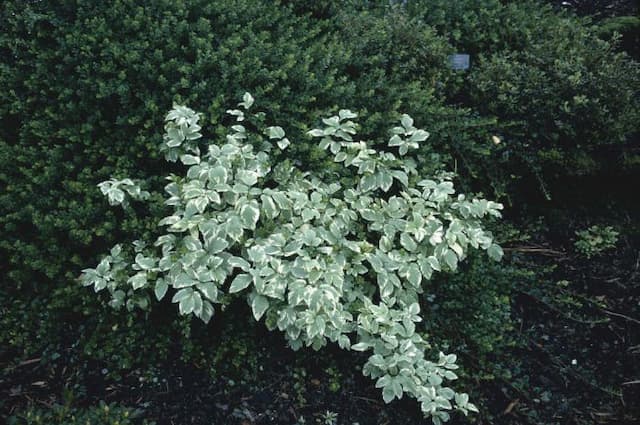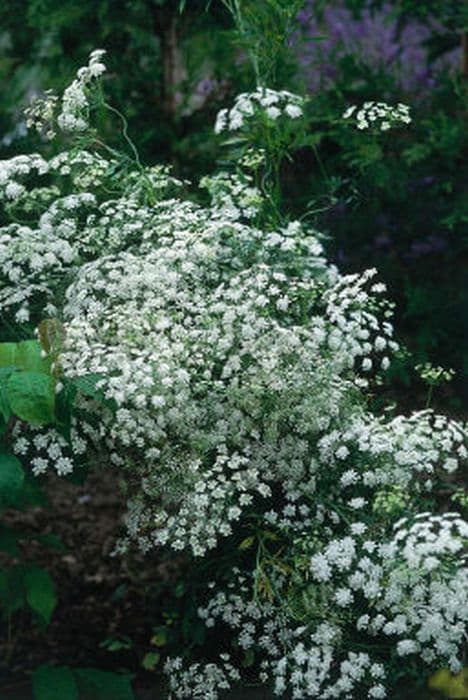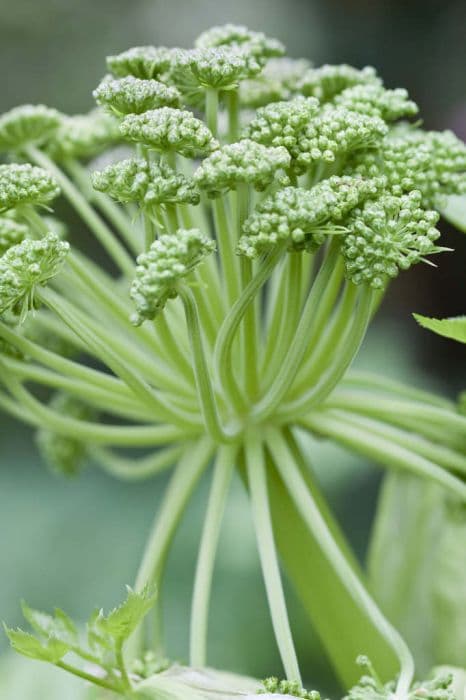Great Masterwort Astrantia 'Moulin Rouge' (PBR)

ABOUT
Astrantia 'Moulin Rouge', commonly known as Great Masterwort, has a distinctive and captivating appearance. This plant showcases a striking array of pincushion-like flowers that make a bold statement in any garden. The flowers of 'Moulin Rouge' are characteristically deep crimson to maroon, a darker shade than most other varieties. These flowers are intricately composed of tiny florets that are tightly clustered together, creating a textured effect that mimics a starburst. Each flower cluster is surrounded by a ruff of papery bracts, which are often a lighter pink to greenish, contrasting beautifully with the dark tones of the central blooms. The foliage of Great Masterwort provides an excellent backdrop to the dramatic flowers, with deeply divided leaves that are palmate in shape. The leaves are a fresh green color, with a slightly glossy texture, and can sometimes have a hint of maroon tint to match the flowers, giving a cohesive look to the plant. Astrantia 'Moulin Rouge' blooms in the summer months, offering a prolonged display of its richly-colored flowers. The plant has a bushy, clumping habit and presents an overall lush appearance. Its striking blossoms also are known for their appeal to beneficial pollinators, such as bees and butterflies, adding a lively dimension to the garden as it becomes a hub of activity. In summary, with its luxurious crimson flowers accented by lighter bracts and verdant, divided foliage, Astrantia 'Moulin Rouge' is a distinctive and elegant addition to garden spaces, known for both its visual appeal and its attractiveness to wildlife.
About this plant
 Names
NamesFamily
Apiaceae
Synonyms
Great Masterwort, Hattie's Pincushion, Moulin Rouge Masterwort
Common names
Astrantia 'Moulin Rouge' (PBR).
 Toxicity
ToxicityTo humans
Great Masterwort (Astrantia 'Moulin Rouge') is not commonly known to be toxic to humans. There are no widespread reports of poisoning or serious side effects from ingesting this plant. However, as with many plants, individual sensitivities and allergic reactions may occur, so it is generally advised not to eat ornamental plants.
To pets
Great Masterwort (Astrantia 'Moulin Rouge') is not widely known to be toxic to pets such as dogs and cats. There are no major reports or studies demonstrating significant toxicity or symptoms of poisoning from ingesting this plant. As with humans, some pets could potentially experience mild stomach upset or an allergic reaction if they consume this plant, but this is not common. As always, it is best to keep an eye on pets and prevent them from eating ornamental plants as a precaution.
 Characteristics
CharacteristicsLife cycle
Perennials
Foliage type
Deciduous
Color of leaves
Green
Flower color
Red
Height
1-2 feet (30-60 cm)
Spread
1-2 feet (30-60 cm)
Plant type
Herb
Hardiness zones
5
Native area
Europe
Benefits
 General Benefits
General Benefits- Attracts Pollinators: Astrantia 'Moulin Rouge' is known to attract bees and butterflies, which are vital for pollination.
- Low Maintenance: It is relatively easy to care for, requiring minimal maintenance once established.
- Drought Tolerant: Once established, the plant has good tolerance to dry conditions, making it suitable for drier climates.
- Long Blooming: It offers a long flowering period from early summer to early autumn, adding extended interest to the garden.
- Cutting Garden Addition: The flowers are excellent for cutting and using in floral arrangements.
- Landscape Design Versatility: With its distinctive deep red flowers, it can be used in a variety of garden designs, including borders and cottage gardens.
- Rabbit Resistant: It is generally resistant to damage from rabbits.
- Deer Resistant: The plant is also less palatable to deer, reducing the likelihood of grazing.
- Winter Interest: In some climates, the seed heads can provide visual interest during the winter months.
 Medical Properties
Medical PropertiesThis plant is not used for medical purposes.
 Air-purifying Qualities
Air-purifying QualitiesThis plant is not specifically known for air purifying qualities.
 Other Uses
Other Uses- Photography Subject: Astrantia 'Moulin Rouge' is often used in macro photography due to its intricate star-shaped flowers and striking deep red hues.
- Dried Flower Arrangements: The blooms of Astrantia 'Moulin Rouge' can be dried and used in arrangements where they provide texture and maintain their color well.
- Natural Fabric Dyes: The deep red pigments in Astrantia 'Moulin Rouge' flowers may be used to extract natural dyes for coloring fabrics.
- Floral Art: The unique structure of Astrantia 'Moulin Rouge' flowers makes them a popular choice for contemporary floral art and design projects.
- Garden Photography Workshops: The plant can be a focal point in garden photography classes, teaching techniques like background blur and composition.
- Bee Garden Feature: As a nectar-rich plant, Astrantia 'Moulin Rouge' can serve as an attractive feature in gardens designed to support pollinators like bees.
- Fairy Gardens: The delicate and intricate look of Astrantia 'Moulin Rouge' makes it suitable for creating enchanting scenes in fairy and miniature gardens.
- Culinary Garnish: While not widely known as an edible flower, the petals of Astrantia 'Moulin Rouge' could be used as a unique, colorful garnish for special dishes, after ensuring they are free of pesticides and other chemicals.
- Educational Tool: As an example of radial symmetry, Astrantia 'Moulin Rouge' can be used in teaching biological concepts in botany.
- Botanical Illustration: Artists may choose Astrantia 'Moulin Rouge' for botanical illustration due to its detailed and vivid flowers.
Interesting Facts
 Feng Shui
Feng ShuiThe Masterwort is not used in Feng Shui practice.
 Zodiac Sign Compitability
Zodiac Sign CompitabilityThe Masterwort is not used in astrology practice.
 Plant Symbolism
Plant Symbolism- Unity: The intricate pattern of Astrantia 'Moulin Rouge' symbolizes the coming together of many parts to form a whole, reflecting unity and togetherness.
- Protection: This plant is often associated with protection due to its use in traditional medicine as a healing plant and its sturdy structure, which seems to shelter its inner florets.
- Perseverance and Strength: Astrantia 'Moulin Rouge' thrives in various conditions and has a strong root system, making it a symbol of perseverance and strength through adversity.
- Elegance and Grace: With its striking red flowers and poised appearance, Astrantia 'Moulin Rouge' exudes an air of elegance and grace, often symbolizing these qualities.
- Mystery and Intrigue: The depth of color and complex structure of the 'Moulin Rouge' variety can evoke feelings of mystery and intrigue, symbolizing the unknown or the hidden depths of personality or emotion.
 Water
WaterGreat Masterwort should be watered when the top inch of soil feels dry to the touch. Generally, this means watering deeply once a week, but frequency can increase during hot, dry spells. Water at the base of the plant, avoiding wetting the foliage, to reduce the risk of fungal diseases. Aim to provide about 1 to 1.5 gallons of water per plant for each watering session, ensuring even soil moisture. During winter, reduce watering as the plant requires less moisture due to dormancy.
 Light
LightGreat Masterwort thrives in partial shade, though it can tolerate full sun in cooler climates. The best spot for this plant is one where it receives morning sunlight and afternoon shade, protecting it from the intense heat of the midday sun. Bright, indirect light will help promote healthy growth and abundant flowering without scorching the leaves.
 Temperature
TemperatureGreat Masterwort prefers temperatures between 65°F and 75°F for optimal growth, but it can tolerate a range from 50°F to 80°F. The plant is hardy and can survive winter temperatures as low as -30°F, making it suitable for growing in a variety of climates. However, protection from frost is advisable to prevent damage to the foliage and flowers.
 Pruning
PruningPruning Great Masterwort promotes bushier growth, removes spent blooms, and encourages new flowers. Deadhead faded flowers regularly throughout the blooming season to maintain a tidy appearance and stimulate further blooming. Cut back the entire plant to the ground in late fall or early winter after the first hard frost to prepare it for dormancy and ensure vigorous growth in the spring.
 Cleaning
CleaningAs needed
 Soil
SoilGreat Masterwort thrives in moist, well-drained soil enriched with organic matter. A mixture consisting of garden soil, compost, and a small amount of sand or perlite to improve drainage makes an ideal soil mix. The soil pH should be slightly acidic to neutral, around 6.0 to 7.0.
 Repotting
RepottingGreat Masterwort does not require frequent repotting and generally prefers to not be disturbed. Repotting can be done every 2-3 years or when the plant has outgrown its container.
 Humidity & Misting
Humidity & MistingThe Great Masterwort prefers moderate to high humidity levels. It thrives if the humidity around the plant remains consistently above 50%.
 Suitable locations
Suitable locationsIndoor
Provide bright indirect light and keep soil moist.
Outdoor
Plant in partial shade and maintain moist soil.
Hardiness zone
4-7 USDA
 Life cycle
Life cycleAstrantia 'Moulin Rouge', also known as Masterwort 'Moulin Rouge', begins its life as a seed, sown in well-drained soil in the spring or autumn. It then germinates, typically within a few weeks, depending on soil temperature and moisture levels. Following germination, seedlings develop into juvenile plants with a rosette of leaves at the soil surface. As the plant matures, it develops a strong root system and begins to produce characteristic branched stems with deeply lobed, dark green leaves. During the flowering stage in early to mid-summer, it produces striking, pincushion-like burgundy flowers that are highly attractive to pollinators. After the flowering period, seeds are produced and dispersed, completing the cycle, while the plant itself typically dies back to the ground in winter and re-emerges in spring.
 Propogation
PropogationPropogation time
Spring-Early Summer
The common name for Astrantia 'Moulin Rouge' (PBR) is Great Masterwort, and the most popular method of propagation for this plant is by division. This method is usually carried out in the early spring or fall. To propagate by division, carefully dig up the plant, making sure to keep a good amount of the root system intact. The root clump can then be gently pulled apart into smaller sections, ensuring that each new section has a portion of the root system attached. These divisions can then be replanted in well-draining soil, ideally in a location that receives partial shade and maintains consistent moisture. Water the new plantings thoroughly to help establish them. Division helps to create new plants that are true to the parent's characteristics and is generally a quick and effective way to increase your stock of Great Masterwort.









